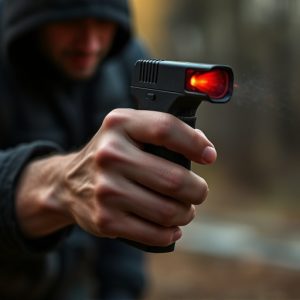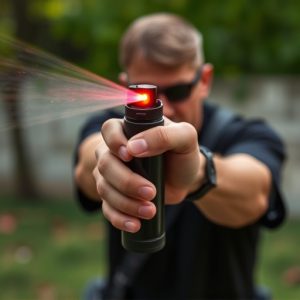Unraveling Pepper Spray Potency: A Guide to Civilian Protection
Understanding pepper spray potency is crucial for civilians looking for effective self-defense optio…….
Understanding pepper spray potency is crucial for civilians looking for effective self-defense options, as different brands vary greatly in capsaicin units (CU), indicating potency. Reputable manufacturers provide detailed information on brand-specific potencies, empowering consumers to match their protection needs. Potency, application technique, and environmental conditions significantly impact the effectiveness of pepper spray, with higher CU enabling quicker incapacitation but proper usage being equally vital.
In today’s world, personal safety is paramount. For civilians seeking effective self-defense tools, pepper spray stands out as a popular choice. This article delves into the critical aspect of pepper spray potency, specifically examining different brands and their potencies. Understanding the variations in pepper spray potency by brand is essential for informed decision-making regarding civilian protection. We analyze key factors that influence effectiveness, empowering readers to choose the best defense against potential threats.
- Understanding Pepper Spray Potency: What You Need to Know
- Brand Analysis: Comparing Pepper Spray Potencies in Civilian Protection
- Factors Influencing the Effectiveness of Pepper Spray for Self-Defense
Understanding Pepper Spray Potency: What You Need to Know
Understanding Pepper spray potency is crucial for civilians looking to protect themselves. The effectiveness of pepper spray varies significantly between brands, with potency measured in capsaicin units (CU). A higher CU indicates a more potent spray, capable of neutralizing an attacker by causing temporary blindness, coughing, and difficulty breathing.
When comparing different brands, it’s essential to look at the stated potency and consider independent testing results. Some reputable manufacturers provide detailed information about their pepper spray potency by brand, allowing consumers to make informed decisions based on specific needs for personal safety.
Brand Analysis: Comparing Pepper Spray Potencies in Civilian Protection
When considering pepper spray for civilian protection, understanding the variations in potencies among different brands is essential. Each brand formulates its pepper spray with specific capsaicin concentrations, ranging from mild to extremely potent. These differences can significantly impact the effectiveness during self-defense scenarios or when deterring potential threats.
A comprehensive analysis of various brands reveals a wide range of pepper spray potency levels. Some brands market their products as ‘law enforcement-grade,’ indicating higher capsaicin concentrations, while others cater to civilian use with slightly lower potencies. For instance, brand X offers a 2% capsaicin spray, suitable for personal protection, whereas brand Y’s 5% concentration is more akin to what law enforcement agencies utilize. This comparison underscores the importance of matching pepper spray potency to individual needs and legal considerations surrounding civilian usage.
Factors Influencing the Effectiveness of Pepper Spray for Self-Defense
The effectiveness of pepper spray for self-defense is influenced by several key factors, including the brand and potency of the product. Pepper spray potency by brand varies widely, with some manufacturers producing formulas that are significantly stronger than others. Higher potency pepper sprays can cause quicker and more intense irritation, enabling users to incapacitate an attacker more swiftly. However, potency alone does not determine success; proper usage technique is equally crucial. Inaccurate application or inadequate aim can result in the spray missing its target, rendering it ineffective for self-defense.
Additionally, environmental conditions can impact the performance of pepper spray. Wind, temperature, and humidity levels play a significant role in how the spray disperses and the level of irritation it causes. Humid conditions may reduce the effectiveness of pepper spray due to the moisture diluting its active ingredients, while windy environments can cause the spray to blow back onto the user. Understanding these factors is essential for civilians considering pepper spray as a self-defense measure to ensure they select an appropriate product and are prepared to use it effectively in various scenarios.
In evaluating pepper spray potency by brand for civilian protection, understanding the factors that influence effectiveness is key. By comparing different brands and their specific potencies, individuals can make informed decisions about self-defense strategies. Knowing what to look for in terms of active ingredients, delivery mechanisms, and concentration ensures that users are prepared and protected. With this knowledge in hand, folks can confidently navigate potential threats, empowering them to defend themselves effectively in today’s world.


